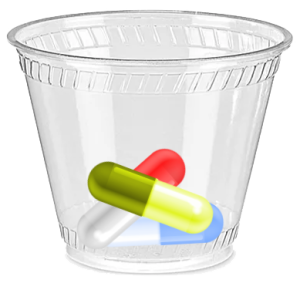
Bioavailability is a measure of the rate at which the active ingredient of a drug is absorbed and becomes available. It represents how much and how quickly a drug reaches the bloodstream. In this activity, student explore how medications dissolve in water (or other substances) and enter the blood stream.
I created this lab to be more open-ended, rather than some of the diffusion labs I use with freshmen. I did not include specific directions on how to set up the labs. With some groups, you may want to give more guidance on how to set up and compare results.
The experiment simply asks the question “How does the liquid taken with medication affect how quickly it dissolves and takes effect in the body?.” Graphics on the student handout remind students that labels on many medications have directions to take with water. Why is that? Could you also take the medication with orange juice or coffee?
A secondary question is about drugs that have an enteric coating. These medications have a coating that prevents disintegration in the stomach. An enteric coating resists dissolution under acidic conditions, but is freely soluble at the more basic conditions of the intestinal tract. Low-dose aspirin typically has an enteric coating. Due to this coating, the directions on the label require you to take with water.
Overview of the Activity
Students begin the activity by reading about the different types of pain relievers and their active ingredients, acetaminophen, ibuprofen, naproxen, and acetylsalicylic acid. With a list of materials, students design an experiment to determine how quickly the medication dissolves in different liquids.
You may want to give a little guidance here and limit resources, because medication can be expensive. Plus, that mirrors how scientists must work with limited funding. You can buy the generic versions of the medications and give students 2-4 of each type. To save time, place the pills in little medicine cups, and the cups can also be used to run the test. It may also save time to recommend students stir the mixture to simulate the movements of the digestive tract.

In my experience, open-ended labs will often result in a lot of random testing, so it’s a good idea encourage students to focus on one or two variables. The student handout has an area where students describe or sketch their design. You may want to require approval of their design before passing out the materials.
Students record their data in a table and use that data to answer analysis questions. One application question explores how different drugs have different routes of administration. The graph compares these routes to the concentration of the drug in blood plasma.

